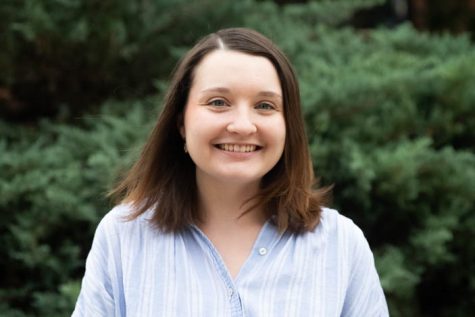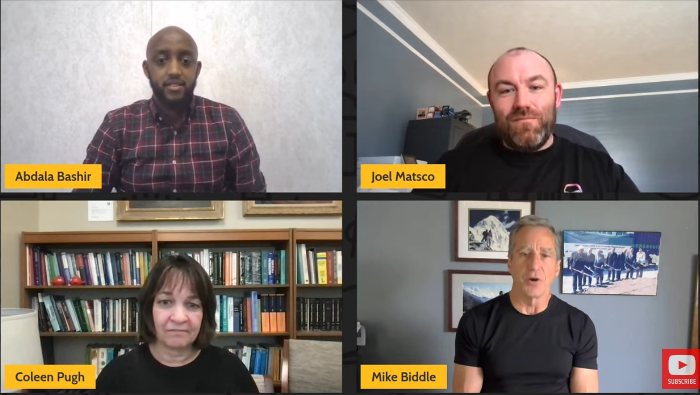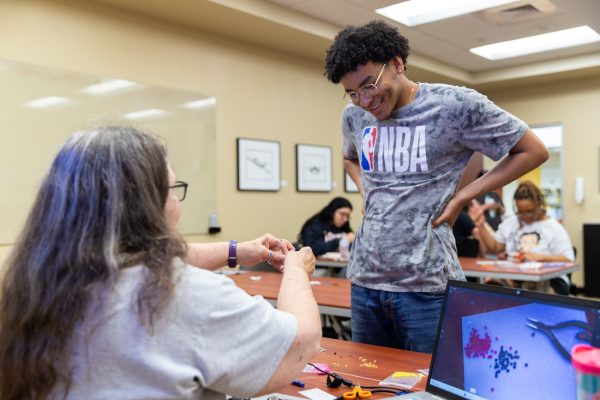Movement of plastics industry toward sustainability: panel discussion
The panel discusses the use of plastics and how people can bring more sustainability to their lives.
On Friday, April 30, the last event for the Shockers Go Green events took place, discussing the harmful effects of plastic on our environment and what leaders in every industry are doing to try to find a solution.
“About 40% of plastics produced today are single-use plastics,” Dr. Coleen Pugh, moderator and chemistry professor said. “Half of the plastics that have been made, have been made in just the last fifteen years. 2% of plastics are recycled into products with a similar function as what it started with.”
Every panelist gave a short presentation about their career and their knowledge about plastic, as well as what they have been working on to solve the problem of plastic. Afterwards, there was a brief panel discussion open for questions from the audience.
Mike Biddle, from Evok Innovations, said that he started his career in the 1970s when plastic was one of the ‘grooviest materials on the planet.’
“In the 70s, we were worried about how in the world were we going to have stable, raw materials to make our plastics. In the 80’s, we were worried about what the world was going to do with our end of life products that we were making so much more of,” Biddle said.
Biddle said that the U.S started shipping the difficult to recycle materials overseas, mostly to China and Southeast Asia. They would pick through what they could and the rest would end up in water sources, which flow into the oceans. This has had a significant negative impact on marine life.
“You will find plastic in your sea salt, your bottled water, even your beer . . . They are finding it in Rocky Mountain snow and rain,” Biddle said. “There was a study released not to0 long ago that estimated that Americans ingest annually about 40-50 thousand particles of microplastic a year. Including inhalation, that goes up to 100 thousand particles per year.”
Biddle said the answer is not to ban plastic, because it is one of the most efficient and best environmental material choices for many products. The answer to our plastic problem is recycling.
“The CO2 going into oceans has had a huge impact on the PH level of oceans . . . the combination of heat and acidification through the absorption of CO2 in the oceans has had a huge impact, it saved us on the land, but it’s had a huge impact on the oceans. The oceans are critical to life on the land,” Biddle said.
Biddle said that while it’s easy to blame big companies for this issue, many individuals can make easy changes to their lifestyle such as going solar, driving less, air-drying clothes, and going vegan that will lessen their carbon footprint. Biddle said that if consumers demand things are made in different ways, we can have enormous impact.
Joel Matsco, Covestro senior marketing manager for the polycarbonates division, said that polycarbonate is a very tough plastic that has higher heat resistance and can meet the design challenges of various electronics.
“What we are working on today is removing ourselves from fossil sources and finding other bio-based or bio-circular sources to manufacture our plastic . . . This is really driven by the market, and it is really driven by the end consumer,” Matsco said.At the end-of-life for products, many are burned for energy recovery. Covestro is looking at ways that we can use bio sources to consume the C02 and remploy that back into production. They are also looking at ‘closing the loop’ on products and reusing plastic used to make previous products.
“Plastics are just too valuable to dispose of. For the energy that it requires, if we can bring it back into a useful life a little bit earlier . . . that offers a much higher value than back to the customer. In the end game, we hope to diminish our need for the oil and gas industry,” Matsco said.
Abdala Bashir, from Danimer Scientific, discussed microbial production of polyhydroxyalkanoates as a new way of producing plastics.
“A lot of the plastics are single use plastics, particularly food and this really showcases that the materials being used in the packaging industry are really over-engineered,” Bashir said.
When asked how close we are to using compostable plastics in consumer goods, Matsco said that is almost an entirely different discussion.
“I think we are a number of years off from that, I think it is going to take some special enzyme research,” Matsco said. “I would push the industry towards more chemical recycling, not even risking engineered plastics entering a landfill. It would be a much better pathway, or even better, close the loop at the end of its useful life cycle.”
Biddle said that the future of recycling looks like a multi-step process to get rid of plastic materials.
“It’s a triage. You start with mechanical recycling, you go to traditional chemical recycling . . . and then the leftovers, which will be a small amount could be turned into energy . . . the nice thing about plastics is they lend themselves to a zero-waste solution if you have all the solutions available,” Biddle said.
Bashir said that there is not just one solution to our plastic problem, but many solutions that can work together.
“I think all of these solutions are really complimentary . . . all of these solutions are complimentary, they aren’t in competition,” Bashir said.

Julia Nightengale was a third-year reporter for The Sunflower, previously working as a Copy Editor and News Editor. Nightengale is a graduate student working...









priestmandela • Jan 20, 2022 at 4:55 am
HOW TO GET YOUR SELF IN ILLUMINATI SECRET SOCIETY FOR MONEY(+27815693240 )IN UK , USA, SOUTH AFRICA, GHANA JORDAN, Kuwait, Turkey, Belgium, Saudi Arabia, Australia, Malaysia, Zambia, USA, Kenya, Dallas, England, German, Spain, Jamaica, St, Lucia, Brasil, Germany, Austria, Vancouver, Denmark, Hong Kong, China , Australia, Wales, France, Harare, Cairo, Philippines , China, Norway, Sweden, Botswana, Namibia, Tanzania,London, Sweden, Denmark, Rwanda, Oman, Qatar, Dubai, Poland, Lesotho, Canada, United Kingdom.and all over the world. For those who are interested in making money all the time, every good thing comes with money, comes with extra effort , All u need do is a “Spiritual work” and every wicked power delaying ur progress wants clear and good things will come to you like, money, favor from people, open doors, business breakthrough, good job. Etc. For more info you can call +27815693240 Note: It’s not a child’s play, it’s for those who are desperate and ready to make a change in their life. Join SERVICE TO HUMANITY !!! Call Agent naseef +27815693240 We are seeking that special wisdom and knowledge that would set us free from the bondage to dull and dreary everyday life, while strengthening us in body, mind and spirit, and bringing us the material rewards of wealth, love, and success. The karishika Brotherhood is a true brotherhood of secret knowledge and power. membership into our fraternity is free and normally through a thorough screening. we are here to liberate those who need wealth, riches, power, prosperity, protection and success in all ramification. Illuminati brotherhood offers all initiate members growth, wealth, fame, power, prosperity and success in all areas of heart desires. we don’t demand human sacrifice, the use of any human parts or early personal death as a precondition for you to become our member. we are not suppose to be on the internet but because of questions and comments join secret society or cult to make money how can join occult for riches i want to be rich but i don’t know how etc. how do i do money ritual how do i join good occult that will not affect me and my family forever we are now and some of our benefits are power, rich,fame, healthy, house,cars,jobs,security,education,deplomatic passport,citizenship ant any countries of your choice,here for you.kindly contact us on +27815693240 or email:[email protected] or https://www.join-illuminati-official.com/
priestmandela • Jan 20, 2022 at 4:54 am
World SSD Chemical solution company @Ltd to clean all black type notes call +27678263428..
ssd-chemical-Solution used to clean all type of blackened, tainted and defaced bank notes. Our technicians are highly qualified and are always ready to handle the cleaning perfectly. Our Chemicals is 100% pure.We sell Chemicals that clean all types of black note or deface note.anti-air breezed powders çand other many products used in cleaning black note. We do offer the best chemicals. if you are far, we will send one of our technician to come to you and clean all your money. Our Products – Ssd solution,Anti breeze,Black,black money,Cleaning,anti-breeze bank notes,Black Dollar, Activation Powder,black coated notes,Vectrol paste,Cleaning chemical,Tebi-Manetic solution, Defaced currency,Black coated notes,Cleaning black money,super automatic solution, stained money,black market currency,cleaning Black money,Cleaning money,notes, Black Currency Cleaning Chemical,SSD Automatic Solution,Money Cleaning Solution, Black Stain,black money chemical. Please contact us for any assistance Via email: [email protected] Call +27678263428 To All Countries in The World/((Continental))eg:
Europe = United Kingdom, Albania,Andorra,Armenia,Austria,Belgium,Bulgaria,Croatia,Cyprus,Czechia,Denmark,Estonia,FinLand,France,Georgia,Germany,Greece,Hungary,Iceland,Ireland,Italy,Latvia,Malta,Monaco,Netherlands,Norway,Poland,Portugal,Russia,Romania,Spain,Sweden,Switzerland,Turkey,Ukraine,and other countries.
Africa : South Africa,Botswana,Angola,Burundi,Algeria,Djibouti,Egypt,Eritrea,Gabon,Ghana,kenya,Lesotho,Libya,Madagascar,Malawi,Mauritania,Mauritius,Morocco,Mozambique,Namibia,Rwanda,Seychelles,South Sudan,Sudan,Tanzania,Tunisia,Togo,Uganda,Zambia,Zimbabwe ,ETC
North America : United States of America, Canada, Bahamas,Barbados,Costa Rica,Cuba,Dominica,El Salvador,Haiti,Mexico,Panama,Saint Kitts and Nevis,Trinidad and Tobago,Jamaica,Honduras,Antigua and Barbuda ,ETC
South America : Argentina, Bolivia,Brazil,Chile,Colombia,Ecuador,Guyana,Paraguay,Peru,Suriname,Uruguay,Venezuela,ETC
Australia : Micronesia, Fiji, Kiribati, Marshall Islands, Nauru, New Zealand, Palau, Papua New Guinea, Samoa, Solomon Islands, Tonga, Tuvalu and Vanuatu.ETC
Asia : United Arab Emirates/Dubai,Afghanistan, Armenia, Azerbaijan, Bahrain, Bangladesh, Bhutan, Brunei, Burma, Cambodia, China, East Timor, Georgia, Hong Kong, India, Indonesia, Iran, Iraq, Israel, Japan, Jordan, Kazakhstan, Kuwait, Kyrgyzstan, Laos, Lebanon, Malaysia, Mongolia, Nepal, North Korea, Oman, Pakistan, Papua New Guinea, Philippines, Qatar ETC
Antarctica :Argentina, Australia, Belgium, Chile, France, Japan, New Zealand, Norway, South Africa, United Kingdom, United States and USSR).ETC.for more information call +27678263428 or via [email protected]